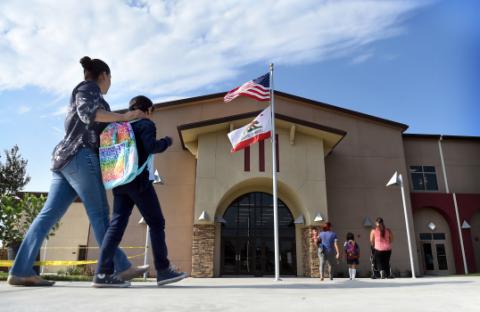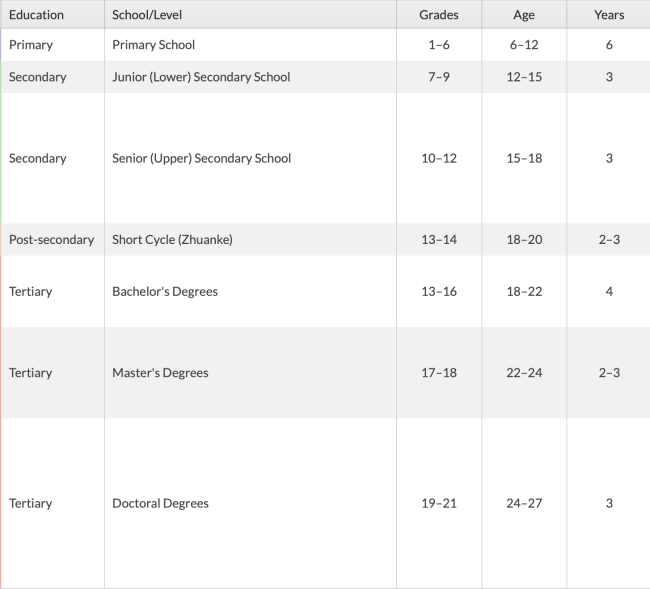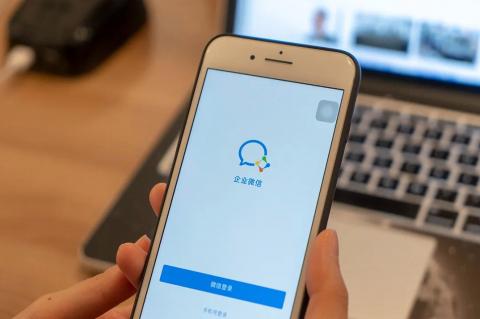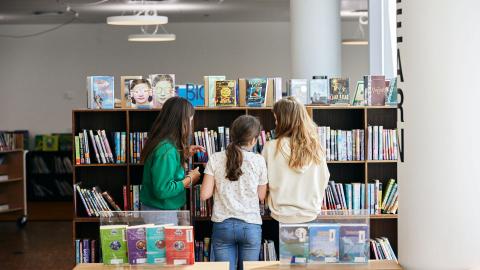
 0
0
Chinese Education System
Introduction
A solid and well-structred education system is indispensible for the development of society. Good education could not only enhance their academic knowledge and transferrable skill, but also cultivate a sense of resposibility for the family as well as the nation. China has a wide range of schools from kindergartens, primary schools to high schools and universities.
China's education system basicly comprises primary education, secondary education and higher education. The primary school in China consists six academic years. The secondary school in China has been seperated into junior secondary school and senior secondary high school, each of which has three academic years.

Education in Primary School (Grade 1 to 6)
Primary education in China is intended for children aged from 6 to 12 and lasts 6 years. Usually the language of instruction in public schools is Mandarin. The curriculum in primary schools often involves Chinese, Mathematics, Nature, Social Studies, Physical Education, Ideology and Morality, Music, Art, and Labor Studies. To graduate from primary schools, students have to attend the final examination in Grade 6 in the subjects of Chinese and Math. The final examination is often coordinated with the local educational authority to take students' further study in secondary schools into consideration.
Nine-year Compulsory Education Policy
The nine-year compulsory education is comprised of 6 years in primary schools and 3 years in junior high schools, implemented comprehensively and made steady progress since the promulgation of Compulsory Education Law of the People's Republic of China. Generally speaking, compulsory education serves as a public welfare undertaking that Chinese government has guaranteed for all school-age children.
According to the report from Ministry of Education of the People's Republic of China, from 2010 to 2014, it is estimated that the Gross Enrolment Rate in primary schools remained between 103.8% and 104.6%, the Enrolment Rate remained between 98.0% and 98.7% the Gross Enrolment Rate in junior secondary schools increased from 100.1% to 103.5%, the Enrolment Rate rose from 87.5% to 95.1%, and the popularization of compulsory education was remarkable. Generally, from 2010 to 2014, the Consolidation Rate of nine-year compulsory education in China increased from 87.5% to 92.6% year-on-year.
In 2014, the national average budget for primary school students increased by 3,668.51 RMB, or 91.43 percent, compared with 2010, and the junior high school increased by 5,145.42 RMB, an increase of 98.67 percent. During the same period, the national average budget expenditure on public funds for primary school students increased by 141.09 per cent over 2010, while the expenditure on public funds in the national primary school year increased by 120.66 per cent over 2010.
Education in Secondary School (Grade 7 to 12)
Secondary school including middle school and senior high school would last 6 years after students' graduation from primary schools.
Middle School (Grade 7 to 9)
Students graduating from primary schools are required to attend the junior secondary schools for the next 3 years. The curriculum in junior secondary schools mainly include Chinese, English, Mathematics, Science, Social Studies, Physical Education Music and Arts. Students who choose to continue their education in senior high school should prepare for Zhongkao to enrol in a preferred senior high school.
Senior High School Entrance Exams (Zhongkao)
The exam for Senior High School Entrance is named Zhongkao in Chinese, literally "Middle Exam". Junior high school entrance is an important event for most students in China. The examination is a precondition for entry into the educational institutions which cover secondary schools, vocational and technical high schools and general senior high schools. The examination is held annually and a large number of students participate in it.
If you want to get more information about Zhongkao, please read another blog article 'Zhongkao' created by TopTutorJob.
Senior High School (Grade 10 to 12)
After Zhongkao, students choose to study in senior high schools will continue to learn comprehensive knowledge of subjects. Then, students who opt for higher education in universities will strive to work hard to achieve higher grades in Gaokao. Most of the curricula in senior high school ls is quite similar to that of middle school would confront a decision to focus on literature&social art studies or science&technology studies while receiving shared compulsory courses in Chinese, Maths, and English.
National Higher Education Entrance Examination (Gaokao)
Gaokao, arranged and conducted by local educational authorities, encompasses the slight different subjects in comparison to the junior secondary graduation exam. Senior high school students seeking admission to post-secondary education are expected to take the National Higher Education Entrance Examination at the end of their final school year. It is the most important examination for most Chinese students, for the results determine which university they are qualified to register into.
If you want to get more information about Gaokao, read another blog article 'Gaokao' created by TopTutorJob.

Higher Education
Students can receive a bachelor's degree in universities, as in many other nations, and continue to a Master's and Doctoral degree. Most of China's universities require students to opt for a specific major rather than let them decide after taking a precondition course.
Project 211 and 985
Project 211 is the initiative of the Chinese Government to improve approximately 100 higher education institutions and core educational subjects as a national objective for the 21st century, which comprises 112 Universities. The initiation of Project 211 is an significant step taken by the Chinese government in its attempt to promote higher education growth in the light of advancing the country in the social and economic fields.
Project 985 is a collaborative initiative undertaken by the Chinese government to create world-class universities in the 21st century. President Jiang Zemin announced on May 4, 1998 that China will have a range of first-rate, globally qualified universities and thus Project 985 was initiated. In the initial process the proposal involved nine universities. The second stage, launched in 2004, enlarged the program and it has now reached 39 universities. Universities recognized as 211 and/or 985 university are regarded as the top tier of universities in China.
Unified National Graduate Entrance Examination
The Unified National Graduate Entrance Examination, for short, is the Graduate Entrance Examination. The examination is held by the educational department and the admission institutions for the selection of graduate students who want to continuous learning and get a master's degree. The examination consists of the initial examination and re-examination organised by authorities and admissions units. It is a selection test and is organized every December.
Chinese Education Culture
Confucianism, imperial examination system and new era in education respectively represent the three eras of Chinese education culture.
Confucius pioneered the education of ancient China and established the earliest private school called 'Sishu'. From the Sui and Tang Dynasties to the Qing Dynasty, the imperial examination system had become an examination system for selecting officials. In the modern era, the form and content of teaching and examinations have caused new reflections and improvements in China.
This part will introduce the three stages of Chinese Education Culture in detail.
Confucianism
Confucius is the founder of Confucianism. Confucianism is regarded as one of the most influential theories in ancient China, since Dong Zhongshu of Han dynasty promoted the policy "respect Confucianism only, and dismiss other schools of thought".
Confucianism has a profound influence on Chinese culture. In the feudal society for thousands of years, the Chinese have taught the Four Books and the Five Classics from generation to generation. The emphasis on responsibility, the notion of loyalty and filial piety, the idea of forgiveness (do not let others do what you do not want), and ethical thoughts are all originated from Confucianism.
Although most of theories in Confucianism cannot adapt to today's education values, many teaching methods can still be referred as insights. First of all, Confucius advocates heuristic teaching. He changed the dominant position of teachers in teaching and encouraged students to become active. Second, he promoted teaching methods should be diverse and in adherence to each student' personalities and interests, namely "differential teaching". Third, he advocated the combination of learning and thinking. Lastly, Confucius put forward the idea of lifelong learning, which has a profound positive influence on Chinese education.
Imperial Examination System
The imperial examination system is a system by which China and neighbouring countries select officials through examinations. Historians have yet to reach a shared conclusion on when the system began to work, but all agree that it ended in the 31st year of Guangxu in the Qing Dynasty (1905), lasting for more than 1,300 years.
The main examinations of the the system are held regularly. It was the fairest form of talent selection that could be adopted in the feudal era. It expanded the social dimension of talents introduced by feudal countries and absorbed a large number of people from middle and lower classes into the ruling class. Especially in the Tang and Song dynasties, the early imperial examination system showed a dynamic and progressive nature and formed a golden age of the development of ancient Chinese culture.
New Era in Education
In the 1980s, China's education was divided by the stage of restoration and reconstruction after the Cultural Revolution, and the value of education has undergone a macro change. The government emphasizes the function of education on economic and social development rather than serving politics.
Since the mid-1990s, Chinese education has developed rapidly both in scale and quality, and education is intended to serve all people in the society. During the social changes in the transition to the market economy system, the rise of private education, the restoration of social schools, and the diversified social and cultural spaces are gradually taking shape.
Since 2003, the concept of "people-oriented" education has been put forward. The education policy has changed, giving priority to the development and investment of education, and promoting education fairness and justice.
Chinese School Year and School Hours
Chinese School Year
The school year of primary and secondary schools has been seperated into two semesters. Different schools' teaching sessions and holidays vary accordingly.
| School Type | Teaching Sessions | Additional Weeks in Reserve | Holidays |
| Primary Schools | 38 weeks | 1 week | 13 weeks |
| Middle School | 39 weeks | 1 week | 13 weeks |
| Senior High Schools | 40 weeks | 2 weeks | 10 weeks |
Chinese School Day
China's school day differs markedly from that of America. Students in America jostle for the next class and a better position. In a contrast to a typical American school day pattern, students in China usually stay in one classroom and wait for their teachers' rotation.
sIn addition, the length of a school day in China is different from that of America. American schools in most cases start at 8 in the morning and end at 3 in the afternoon whereas Chinese schools typically begin with a morning session at 7 am and end with an optional evening self-study session at 9 pm. Most of Chinese schools offer two-hour lunch break when students could take a nap.Chinese Education System






